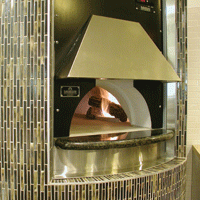Foodservice operators who invest in wood-burning ovens are willing to accept the cost and installation drawbacks to emjoy the equipment’s culinary possibilities.
The foodservice industry’s community of wood-burning-oven enthusiasts may be small, but one thing stands out about these intrepid operators — they’re passionate about their equipment.
Anyone committed to investing in wood-burning ovens has to love them since they’re expensive ($7,000 to $15,000 or more) and incredibly heavy (from two to three tons), requiring a forklift and a rather unusual skill set to install.
The good news is wood-burning ovens come in all shapes and sizes — they can be purchased fully assembled or in modular kits for assembly on site (a bonus if you don’t have big openings to get the unit into the building). There are even combination wood-burning/gas ovens. In some cases, these are installed as a backup alternative in the event of the introduction of municipal bylaw bans on wood-burning ovens. Modular kits cost about half of a pre-assembled unit ($6,500 versus $13,000, in the case of one manufacturer), with gas combos adding approximately another $5,000 to the tab.
This wealth of choice wasn’t available in the 1980s, when Ian Sorbie, president of Il Fornello Restaurants in Toronto, became one of the first operators to install a wood-burning oven. He quickly discovered supply was limited, costs were high and the construction quality wasn’t up to commercial standards.
The restaurateur’s only recourse was to start his own line. “We decided to work with someone to create a wood-burning pizza oven out of food-grade fire brick. We went through the ULC [Underwriters Laboratories Canada] testing process, got approved and started doing sales and installations for other restaurants,” he says. The subsequent explosion in demand for traditional-style Italian pizza brought more products to market at a lower cost, he notes. “At that point we got out of the oven business and concentrated on our own restaurants.”
Il Fornello’s newest restaurant in Ajax, Ont., houses its latest wood-burning oven. Ironically, it’s an import: a sleek, dome-shaped Italian-designed number from Naples that costs approximately $17,000 and is destined to become a signature piece. “It’s our new prototype moving forward,” says Sean Fleming, VP of Development for Il Fornello. “We used to have an adobe-style unit, but this is a more contemporary, casual style with some interesting elements.”
Remaining loyal to wood-burning ovens makes sense, he says. “These ovens can bake pizzas at 700°F to 800°F, and hotter ovens cook pizzas faster and more consistently. Also, these things don’t break, which is great in the restaurant business.”
When selecting a unit, Fleming prefers a large floor area that can hold multiple items. The dome shape, in particular, provides a wider area with a low ceiling, which keeps the heat where it’s needed, he says. Given the weight, the oven is installed on a welded wrought-iron stand in the open-kitchen area.
For John Bergen, wood-burning ovens are about the ambiance. The owner’s three City Café Bakery locations in Ontario use the specialized ovens all day, baking everything from bagels in the morning to pizzas and melts in the afternoon. “We’ve had wood-burning ovens since the beginning,” Bergen says. “Even after 13 years, we haven’t had to touch them. They’re quite robust.”
His ovens, sourced from EarthStone in California, have a six-foot diameter and come pre-assembled at a cost of $12,000. “The downside is they weigh about 5,000 lbs., so [you need] strong floors or to put them directly onto concrete to support them,” Bergen says. “You either need a forklift to put them in place or to put them on wheels, which can be a complication.” Another expense is the $2,000 it costs to install a fan on the roof.
Vincent Puorto, owner/operator of Artigiani Pizzeria & Cucina in Montreal, went the modular route with his wood-burning oven, largely because his resto is located in a century-old building. “We couldn’t bring in a pre-assembled unit because of the dimensions. It would have meant removing windows.”
While he doesn’t consider himself an expert, Puorto says the assembly process was relatively easy. “I’ve had it for three years now, and there have been no problems or cracks. And the insulation that was recommended for it was fantastic. This thing can get up to 900°F, and you won’t feel anything if you put your hand on the perimeter wall.” But he discovered part of the installation process was beyond his basic skill level. Experts were needed. For example, a tile specialist familiar with sand-coat techniques installed the Pierre de Boulanger (or ceramic baking stone) before the dome was mounted. After pouring the insulation, workers applied a mosaic tile front-and-copper trim on the 10-foot chimney portion. The chimney liner also required two-inch insulation to withstand temperatures of up to 1200°F.
While initial costs of a modular system are half those of a fabricated oven, installation costs are an equalizing factor, Puorto notes. “It probably cost us $5,000 to $6,000 to install; the chimney alone was $2,000 to $3,000. And finishing costs for the tile work can [be] about $40 to $50 a foot if you’re not careful.”
While wood-burning ovens are banned in Montreal residential homes, Puorto says they are still approved for commercial applications, as long as they’re certified to standards and meet fire-code regulations. In addition, installations must have an architectural plan. “That adds to the costs and can be up to $1,000. But if your installation isn’t approved, a fire department could close you down,” says the operator.
Bergen notes there are always rumblings in some communities about the use of wood-burning ovens, and some municipalities are getting stricter about requirements due to worries about smoke and emissions. He contends the ovens burn remarkably cleanly, because temperatures can reach 1000°F or higher.
Perhaps one of biggest problems with running a wood-burning oven is the cost, which is more than gas. “It’s not cheap using wood, because it’s about $180 a cord, and we go through a couple a month. But we like the aesthetics and the authenticity, so we’re happy to pay it,” says Bergen.
Vendor Information
For a complete supplier’s list visit our Online Buyer’s Guide.





















